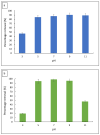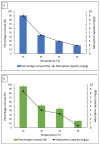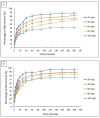Removal of Cationic Dyes by Iron Modified Silica/Polyurethane Composite: Kinetic, Isotherm and Thermodynamic Analyses, and Regeneration via Advanced Oxidation Process
- PMID: 36559783
- PMCID: PMC9786703
- DOI: 10.3390/polym14245416
Removal of Cationic Dyes by Iron Modified Silica/Polyurethane Composite: Kinetic, Isotherm and Thermodynamic Analyses, and Regeneration via Advanced Oxidation Process
Abstract
Emerging dye pollution from textile industrial effluents is becoming more challenging for researchers worldwide. The contamination of water by dye effluents affects the living organisms in an ecosystem. Methylene blue (MB) and malachite green (MG) are soluble dyes with a high colour intensity even at low concentration and are hazardous to living organisms. The adsorption method is used in most wastewater plants for the removal of organic pollutants as it is cost-effective, has a high adsorption capacity, and good mechanical stabilities. In this study, a composite adsorbent was prepared by impregnating iron modified silica (FMS) onto polyurethane (PU) foam to produce an iron modified silica/polyurethane (FMS/PU) composite. The composite adsorbent was utilised in batch adsorption of the cationic dyes MB and MG. The effect of adsorption parameters such as the adsorbent load, pH, initial dye concentration, and contact time were discussed. Adsorption kinetics and isotherm were implemented to understand the adsorption mechanism for both dyes. It was found that the adsorption of MB and MG followed the pseudo-second order model. The Langmuir model showed a better fit than the Freundlich model for the adsorption of MB and MG, indicating that the adsorption occurred via the monolayer adsorption system. The maximum adsorption capacity of the FMS/PU obtained for MB was 31.7 mg/g, while for MG, it was 34.3 mg/g. The thermodynamic study revealed that the adsorption of MB and MG were exothermic and spontaneous at room temperature. In addition, the regeneration of FMS/PU was conducted to investigate the composite efficiency in adsorbing dyes for several cycles. The results showed that the FMS/PU composite could be regenerated up to four times when the regeneration efficiency dropped drastically to less than 20.0%. The impregnation of FMS onto PU foam also minimised the adsorbent loss into the environment.
Keywords: adsorption; advanced oxidation process; iron modified silica; isotherm; kinetic; malachite green; methylene blue; polyurethane; regeneration; thermodynamic.
Conflict of interest statement
The authors declare no conflict of interest.
Figures















Similar articles
-
Dual function of gellan gum-infused polyurethane foam for remediation of methylene blue dye and sustainable acoustic protection.Int J Biol Macromol. 2025 May;310(Pt 1):142833. doi: 10.1016/j.ijbiomac.2025.142833. Epub 2025 Apr 3. Int J Biol Macromol. 2025. PMID: 40187453
-
Appraisal of the adsorption potential of novel modified gellan gum nanocomposite for the confiscation of methylene blue and malachite green.Int J Biol Macromol. 2024 Feb;259(Pt 1):129221. doi: 10.1016/j.ijbiomac.2024.129221. Epub 2024 Jan 7. Int J Biol Macromol. 2024. PMID: 38191115
-
Novel fabricated low-cost hybrid polyacrylonitrile/polyvinylpyrrolidone coated polyurethane foam (PAN/PVP@PUF) membrane for the decolorization of cationic and anionic dyes.J Environ Manage. 2022 Aug 1;315:115128. doi: 10.1016/j.jenvman.2022.115128. Epub 2022 Apr 25. J Environ Manage. 2022. PMID: 35483254
-
Modified Electrospun Polymeric Nanofibers and Their Nanocomposites as Nanoadsorbents for Toxic Dye Removal from Contaminated Waters: A Review.Polymers (Basel). 2020 Dec 23;13(1):20. doi: 10.3390/polym13010020. Polymers (Basel). 2020. PMID: 33374681 Free PMC article. Review.
-
Factors Affecting Synthetic Dye Adsorption; Desorption Studies: A Review of Results from the Last Five Years (2017-2021).Molecules. 2021 Sep 6;26(17):5419. doi: 10.3390/molecules26175419. Molecules. 2021. PMID: 34500848 Free PMC article. Review.
Cited by
-
Ultrasound-assisted formation of composite materials from fish scale waste hydroxyapatite in the presence of gamma-irradiated chitosan for the removal of malachite green.RSC Adv. 2024 Oct 1;14(40):29737-29747. doi: 10.1039/d4ra03102d. eCollection 2024 Sep 12. RSC Adv. 2024. PMID: 39355167 Free PMC article.
-
Design of silver-zinc-nickel spinel-ferrite mesoporous silica as a powerful and simply separable adsorbent for some textile dye removal.Sci Rep. 2024 Jul 17;14(1):16481. doi: 10.1038/s41598-024-66457-4. Sci Rep. 2024. PMID: 39013936 Free PMC article.
-
A Novel High-Efficiency Natural Biosorbent Material Obtained from Sour Cherry (Prunus cerasus) Leaf Biomass for Cationic Dyes Adsorption.Materials (Basel). 2023 Jun 8;16(12):4252. doi: 10.3390/ma16124252. Materials (Basel). 2023. PMID: 37374436 Free PMC article.
References
-
- Nie Q., Nie S. Evaluation Technologies for Food Quality. Elsevier; Amsterdam, The Netherlands: 2019. High-performance liquid chromatography for food quality evaluation; pp. 267–299. - DOI
-
- Tan B. Removal of dyes and industrial dye wastes by magnesium chloride. Water Res. 2000;34:597–601. doi: 10.1016/S0043-1354(99)00151-7. - DOI
-
- Anirudhan T.S., Ramachandran M. Adsorptive removal of basic dyes from aqueous solutions by surfactant modified bentonite clay (organoclay): Kinetic and competitive adsorption isotherm. Process Saf. Environ. Prot. 2015;95:215–225. doi: 10.1016/j.psep.2015.03.003. - DOI
-
- Pessier A.P. Current Therapy in Reptile Medicine and Surgery. Elsevier; Amsterdam, The Netherlands: 2014. Chytridiomycosis; pp. 255–270. - DOI
Grants and funding
LinkOut - more resources
Full Text Sources
Miscellaneous

